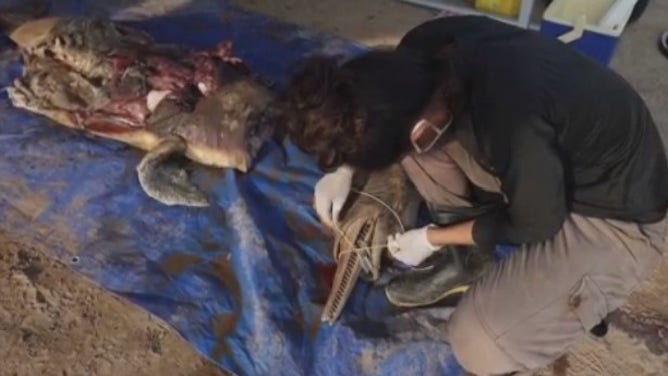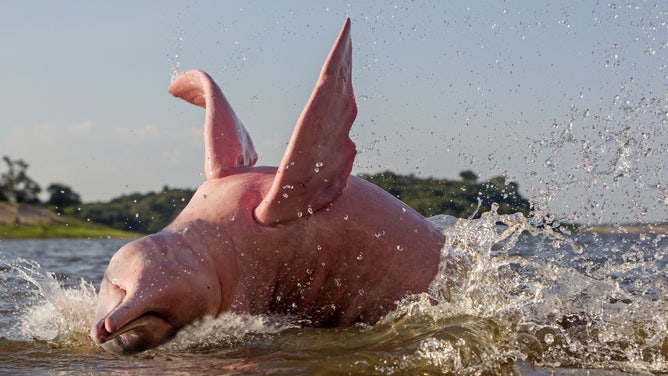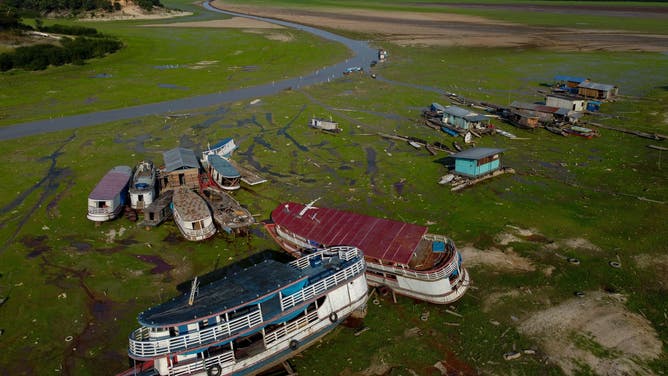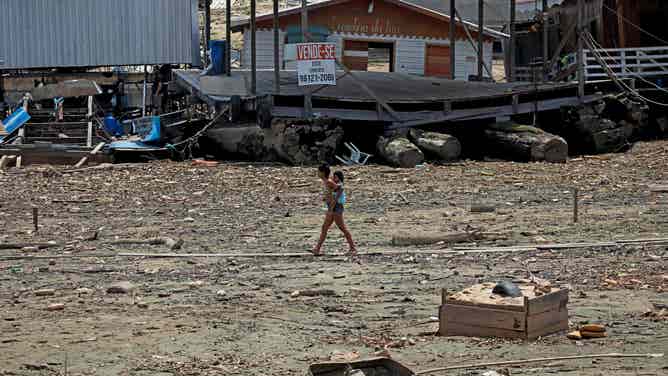Scientists fear heat, drought killed at least 120 rare dolphins in Amazon
Meteorologists blame the extreme drought and heat wave on El Nino. The weather extremes threaten to wipe out an entire species of rare dolphin.
Brazil drought and heat wave kill over 100 rare pink dolphins in Amazon tributary
Severe drought is shrinking the Amazon, only home in the world to the pink Amazon river dolphins. Researchers found at least 120 carcasses in the now shallow tributaries which have heated up to 120 degrees Fahrenheit.
TEFE, Brazil – Researchers have performed necropsies on nearly 120 dolphins that died in the Upper Amazon River system over the past few weeks, where officials believe an ongoing severe drought has caused shallow water temperatures to skyrocket.
The dolphins are the gray river dolphin and the rare Amazon River dolphin, also known as the pink river dolphin. They are only found in Brazil, Bolivia, Colombia, Ecuador, Guyana, Peru and Venezuela, according to the World Wildlife Fund. The pink dolphins are the largest and one of only a handful of freshwater dolphin species left in the world.

A scientist conducting a necropsy on a dolphin.
(Reuters / FOX Weather)
"This represents (about) 10% of the population of the species," Miriam Marmontel, of the Mamiraua Institute, told Reuters. "So, it is a very significant impact because we are close to 5%. You can see that it is the percentage of population replacement (that is in jeopardy). If this modality continues to increase, then yes, we will (have) … a very critical situation."
Species at risk
The dolphin's pregnancy lasts for about 13 months. After that, the mother feeds her calf underwater for two years. So, females reproduce only every three to five years, according to research published in the Biological Journal of the Linnean Society.
"They are a very slow reproductive species," author Vera da Silva and researcher for the Amazon Institute told MongaBay.com. "If the removal is higher (than the reproduction and rearing rate), the species does not have the capacity to replace itself."
Da Silva also found that Brazil's Amazon River dolphin population is halved every decade.
UNUSUALLY HOT FLORIDA SEA SURFACE TEMPERATURES ON TRACK TO CAUSE MASS CORAL BLEACHING EVENT

File: The dolphins are born gray, but some turn pink with age.
( Sylvain CORDIER/Gamma-Rapho / Getty Images)
Boats sit on cracked beds of rivers, lakes
Aerial video from Reuters that was recorded at the end of September showed dolphin after dolphin rotting on muddy banks. Vultures pick at the decaying fish in flocks. Some dolphins are still floating, and the carnivores use the body as an island. Their once brilliant pink skin is now a dark mottled grey-brown.
What looks like streams in the mud used to be channels in a large lake. The level at Rio Negro, monitored by the Port of Manaus, steadily dropped 8-14 inches a day for the last two weeks of September. So far, in the first four days of October, the level dropped more than 2 feet.

In this aerial view, boats are seen stranded in Aleixo Lake due to the severe drought west of Manaus.
(MICHAEL DANTAS/AFP / Getty Images)
The level is only 4.5 feet lower than Rio Negro's record low of all time set in October 2010, according to the port. And shallow waters over dark mud heat very quickly. A geosciences researcher told Reuters that water temperatures in spots of Lago Tefe hit 102 degrees Fahrenheit on the day 70 dolphins died. Water temperatures this time of year are generally between 84 and 87 degrees.
"So it is an extremely high value that certainly has to do with this mortality," said Ayan Fleischmann, a researcher analyzing conditions.
Researchers are also looking at other causes of death like a bacterial infection. They can not move the surviving dolphins to a cooler place until bacteria have been ruled out.
The amount of dissolved oxygen in water decreases as it warms, so the area has also seen a mass fatality of other fish. Brazil's Environment Minister told Reuters that the rotting fish have contaminated drinking water.
FLORIDA EVERGLADES WATER TEMPERATURES REACH HOT-TUB LEVELS

Thousands of dead fish clog the shrinking waterways.
(MICHAEL DANTAS/AFP / Getty Images)
Blame El Niño
Meteorologist Joselia Pegorim told Brazil Reports that El Niño was partially to blame, and conditions will get worse.
"El Niño will act to reduce rainfall in the northern region of Brazil, which could aggravate the drought situation already observed at the end of winter and which will continue into spring, due to the high temperatures in the North Atlantic Ocean and the Gulf of Mexico," Pegorim said.
The Governor of Brazil's Amazonas state declared an Environmental Emergency in mid-September. That allowed funding for humanitarian aid, like food and drinking water, to be brought in. Residents of the Upper Amazon rely heavily on fish as the main source of protein.
STRONG EL NINO WINTER: WHAT KIND OF WEATHER YOU CAN EXPECT

A woman carries a child through a dry riverbed due to the severe drought on the Rio Negro River west of Manaus. House and fishing boats lay on the mud.
(MICHAEL DANTAS / AFP / Getty Images)
The Amazon River, rainforest and seasonal floodplains can rise and fall up to 39 feet a year with tropical rains. The city of Manaus, the capital of the Amazonas, only saw one day of rain in all of August, according to the Climatempo Institute. Levels have been steadily declining since June.
During floods, the Amazon and its tributaries overflow, and the dolphins can swim through rainforest trees and roots in search of food.
The World Wildlife Fund for Nature estimates that the Amazon River dolphin population is in the tens of thousands.
